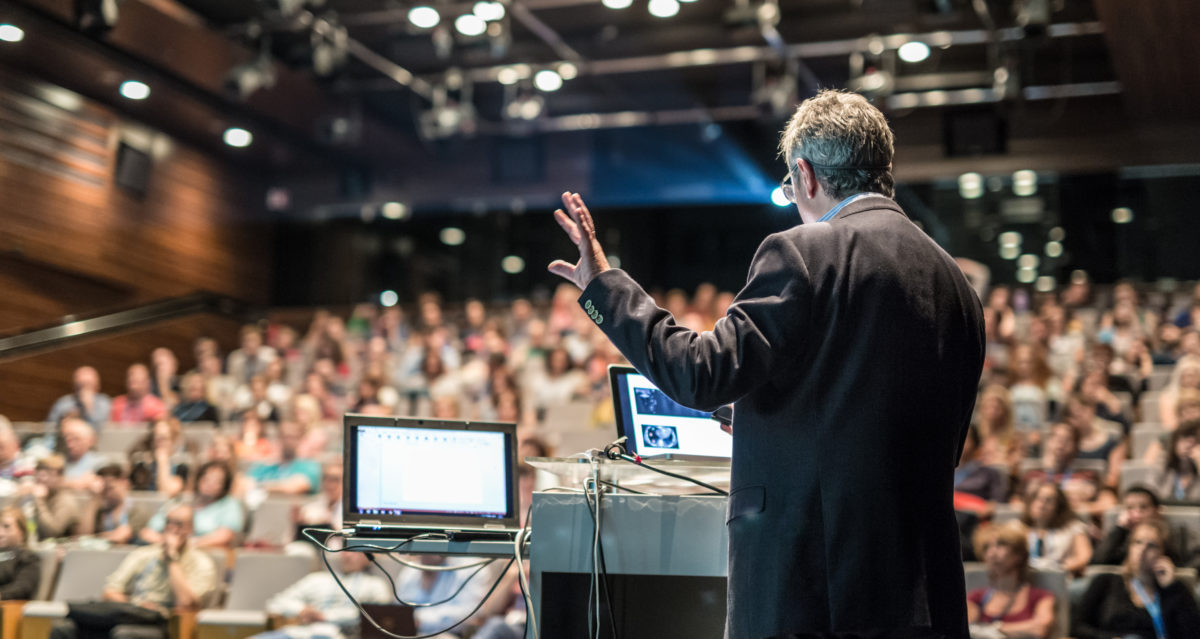A global pandemic doesn’t have many upsides for event planners and marketers. What we do have is a year of lessons learned. When every type of event imaginable was suddenly shifted online, we learned some truths about the “old” way of hosting events. The result is a changed expectation from event-goers as venues reopen their doors for online and in-person events.
While 2020’s online event transitions were not always smooth, with many far from perfect, what we learned was that having the opportunity to attend virtually made many events accessible in ways that in-person-only events could never be. Ultimately, we have learned that there is no going back. The future of events is the hybrid event — a seamless blend of in-person and virtual experiences to create greater value for both groups.
You might think that planning a hybrid event simply means planning your event as usual and then bolting on the online component. Alas, the best way is the complete opposite. There are many considerations you need to make when planning.
What we learned from moving events online
To understand how to build the best hybrid event strategy, we need to look at some of the challenges. The pandemic arrived, and lockdowns went into effect around the world. Events of every type were suddenly either postponed indefinitely or moved online. And it wasn’t just event organizers for large-scale events suddenly having to learn a new approach.
For companies and business groups, after companies had sent everyone home, the operations team scrambled to work through digital transformation projects they’d expected to have significantly more time to execute against. It was now critical to figure out how to handle company meetings and conferences on top of day-to-day collaboration. Investment in business collaboration tools boomed, but it also exposed their limitations and feature gaps. Workers began suffering video conference burnout. Corporate event planners knew they needed a new strategy to keep their audience engaged in the face of “Zoom fatigue.”
Performers, events staff, and venues all faced unique challenges. Bars, clubs, and concert halls closed. Streamed performances began to pop up across platforms — from solo artists broadcasting via Facebook Live to DJs streaming live sets via Twitch (traditionally seen as a video game streaming service).
At first, all these experiences were jarring as they represented the huge hole that cancellations and closures had left in our lives (and social calendars). Over time, as we all adapted, some silver linings emerged. It was fun to dance in our living rooms. Events we may not have been able to attend physically were easy to tune in to. Workers and family members alike were relieved of expensive travel to attend meetings or celebrations.
Will it blend? Bringing together your online and in-person event experiences.
We’ve looked deeply now at the challenges and lessons learned from the pandemic. The big takeaway is that while it was hard at first, new technologies have emerged to bridge the gaps. People have adapted to having the choice to attend virtually, and the future of event planning must include this element.
But, successful hybrid event planning means far more than just creating an in-person event and bolting on a virtual component. You must be “virtual-first” in your planning and then build your in-person experience around that. There are several questions you must consider as you are planning that will guide your approach.
For meetings, seminars, panels, and the like, think about interactions between the audience and the presenter(s). This is a common pain point, especially for the speakers themselves.
Some questions you must consider are:
- How will attendees of each type interact with the presenter(s)?
- Will audience members of each type be able to interact with each other?
- How will virtual attendees be represented in the physical event space?
More intimate events like weddings and receptions pose additional challenges to ensure that virtual attendees aren’t stuck as observers in the proverbial corner. This requires rethinking not only what technology we use but how we use it.
Let’s take a high-level walk-through of the hybrid event planning process.
Step 1: Plan your hybrid event’s online approach
First, you need to understand the event’s objectives and fully commit to it as a hybrid experience. This means unifying the online and in-person experiences to create equally great value for both types of participants. Let’s plan an example event: an industry trade show. First, we need to identify all the elements that we wish to include in our event:
- Keynote speech
- Individual speaker presentations with Q&A
- Panel discussions with interactive audience
- Trade show floor
- Prepared lunch
- Networking social hour
To properly build out this hybrid event, we must start by looking at the virtual elements for each piece. How will our virtual attendees experience each one?
Keynote Speech
The keynote speech doesn’t include a Q&A, so the audience passively observes, although they may be sharing points that resonate on social media. We want to make sure we deliver an engaging experience for our virtual audience to build the same level of energy and excitement the physical audience experiences.
Individual Speaker Presentations with Q&A
For these presentations, we must make sure that our virtual audience can interact with the speaker for questions, see all presented materials, and of course, see and hear the speaker. We also want our virtual audience not to feel like they are watching from the sidelines — what are some clever ways to increase engagement and interactivity?
Panel Discussions
Like the speaker presentations, we must fully engage the virtual audience and then identify how to integrate the physical attendee experience. Virtual attendees need equal levels of interaction and representation to the panel — how might the overall format of the panel be shifted to accommodate this?
Trade Show Floor
The true highlight of any trade show is the showroom floor. Here vendors have booths full of swag and potential access to important names. Plus, attendees have the chance to meet and interact with each other. Virtual attendees want to have this immersive experience and ability to network — how will we place them inside the showroom floor?
Prepared Luncheon
A catered luncheon with 2-3 meal options. A casual opportunity to talk, network, and make new connections/friendships. What does a virtual luncheon look like? How might virtual and physical attendees connect? How do you keep it from being a sad desk lunch for those not there in person?
Networking Social Hour
A more free-movement opportunity for networking than the luncheon, this is a happy hour style social event. Similar questions as the luncheon apply here. How will virtual attendees “roam the room” and have helpful chance encounters and conversations?
2. Build out your hybrid event
Now that you’ve considered all the event’s online elements and asked all the pertinent questions, it’s time to build out the rest of your event experience. Let’s look again at each portion of our trade show event and think about what features and technologies will create a valuable and interactive experience for your attendees. You will need to determine your Virtual Event Platform. Prepare to build out a custom app that does far more than just provide a map and schedule — it will need to build in connection, communication, and interactive functions (or choose a VEP that has a mobile-friendly interface).
- Individual speaker presentations with Q&A: Broadcast via livestream to virtual attendees with camera views of both speaker and in-person audience. Dedicated moderators work with both audiences to gather questions. Virtual attendees can ask questions/provide comments via audio or submission to a moderator. Additional interactivity comes in the form of audience polls and games via the app.
- Keynote Speech: Broadcast via live stream to virtual attendees. The trade show app gives both virtual and in-person attendees a commentary feed projected alongside the stage.
- Panel Discussions: Questions are collected through the trade show app ahead of time from all attendees. Moderators feed these questions to the panel, which is live-streamed. Live comment feed is broadcast (similar to the keynote).
- Trade Show Floor: Mail swag bags to all virtual attendees. Create a 3D rendering of the trade show floor to allow virtual attendees to see displays and setups. Create virtual sponsored booths for remote attendees to visit and interact with. Use a remote platform that makes swapping contact info easy and fun.
- Prepared Luncheon: Select your lunch menu based on what is easy to ship prepared to attendees’ homes or that can be delivered through a nationwide delivery app partner. Make sure your menus are the same for both. Use a platform that provides accessible breakout rooms or tables for attendees to chat and connect.
- Networking Social Hour: Create lounges and fun spaces for virtual networking. Allow virtual and in-person attendees to connect through a networking “wall” and trade info using the app. Set up game or discussion tables that physical and virtual attendees can join.
You’ve built out your event and determined what features and functions you need. Now you need to sell tickets and get word to your audience. You need to engage both virtual and in-person attendees with a value statement — meaning you need to demonstrate equal value no matter how they attend. This includes emphasizing what makes each special and exciting, whether it be the immersive experience or flexibility and accessibility.
When marketing to both groups, keep the focus on integration and interactivity. Highlight how both groups can benefit from networking and connecting with each other. Provide online networking platforms pre-event to get attendees connected and build hype and excitement. And think about how the addition of interactive platforms enhances both experiences.
The future of events is hybrid
Event coordinators and conference planners are faced with a new event planning landscape, and their event strategy must adapt. Participants have new expectations, and meeting them means investing in a new way of thinking and new technologies to support it. Remember, there is no going back — hybrid events are here to stay. But with the right tools and strategies, you’ll be able to plan and host interactive and engaging events that wow your attendees, no matter how they attend.
Learn more about how Frameable Events can help you create a more engaging hybrid event, or schedule a demo.









